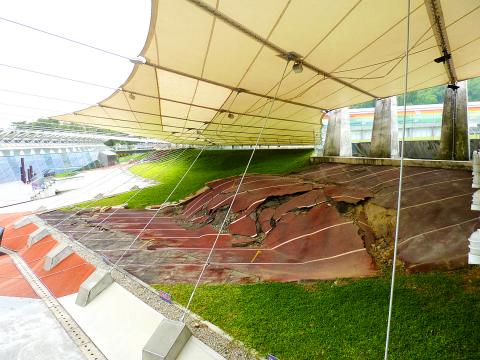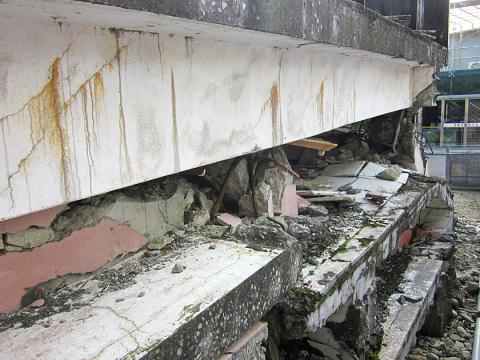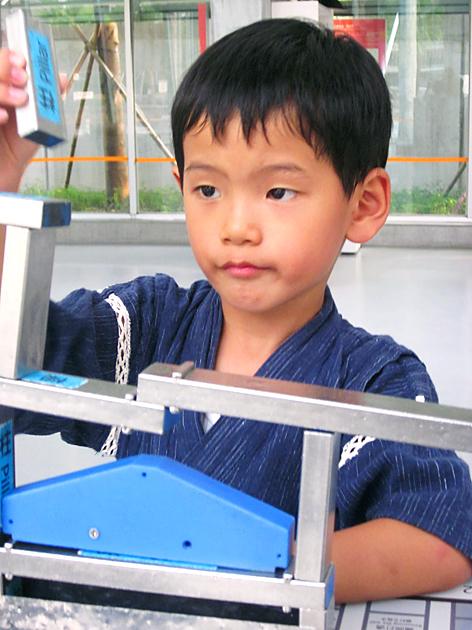Recalling the night when the nation’s worst earthquake in recent memory devastated central Taiwan, Yang Jing-chang (楊景昌) tightened his right biceps to show that he still possesses the power he summoned 14 years ago to rescue two young children from a collapsed building.
A police officer, Yang had just gotten off duty and was still at the station when he felt the ground shake. Then he heard a mother’s desperate pleas.
“Help me, help me,” said Wang to the Taipei Times, citing the woman.

Photo courtesy of 921 Earthquake Museum
With a surge of adrenaline, Yang spent the next four and a half hours with a hammer and shovel, digging through the brick remains of a demolished three-story building, eventually reuniting the mother with her son and daughter.
Yang is now a volunteer at the 921 Earthquake Museum of Taiwan in Wufeng (霧峰). He believes that the museum helps people not only to understand the natural disaster that claimed more than 2,400 lives and injured another 11,300, but also to learn about future earthquakes.
“I want to help visitors understand how to protect themselves from earthquakes,” said Yang, now 58 years old. “We need to know why buildings collapse so this doesn’t happen again.”

Photo courtesy of 921 Earthquake Museum
For visitors too young to have lived through the devastation of 1999, the museum offers games that teach lessons on earthquakes. Earlier this month, four-year-old Yang Zheng-xun (楊政勳) played with toy building materials in an interactive exhibit designed to show how top-heavy buildings without supportive walls are prone to collapse.
“It’s too difficult for him to understand the power of earthquakes,” said his mother, Lin Chiao-ling (林巧玲) of Taipei. “But we’ll come here again when he gets older.”
The museum, a 30-minute drive south of Greater Taichung, attracts over 300,000 visitors a year, half of whom are guided through on school field trips. On an annual budget of NT$60 million, it is maintained by a staff of 30 employees and 270 volunteers.

Photo courtesy of 921 Earthquake Museum
Opened in 2005 where the Kuangfu Junior High School once stood, the museum also offers visitors a glimpse into the past.
Standing before two classrooms now pancaked in a heap of concrete, museum docent Liu Ching-yen (劉青硯) said it’s fortunate that the 7.3-magnitude earthquake struck in the middle of the night, sparing the students and staff.
“The most important lesson here is how to protect yourself,” Liu said. “It’s not a matter of if a big earthquake happens again, but when.”
Throughout Taiwan, there are more than 30,000 earthquakes annually, hundreds of which are routinely felt, Liu said. Occasionally, she added, the nation will be jolted by an earthquake strong enough to inflict widespread damage and casualties.
Preparing for the inevitable, yet unpredictable, event is Liu’s mission. While encouraged by the number of youths visiting the museum, she called on more earthquake education in schools.
“Most of the kids don’t understand how powerful earthquakes can be,” she said.
“We need to talk more about how to protect ourselves.”
MUSEUM HIGHLIGHTS:
Chelungpu Fault Gallery: Showcases the 2.5-meter rise in earth that occurred when the fault ruptured
Earthquake Engineering Hall: Provides home and public safety tips, along with modern earthquake resistance technology
Image Gallery: Provides a simulated earthquake experience
Disaster Prevention Hall: Presents ways to prepare for a range of natural disasters such as earthquakes and floods
Reconstruction Records Hall: Documents the reconstruction efforts in the aftermath of the 1999 earthquake
IF YOU GO:
Where: 46 Zongzheng Road, Greater Taichung (臺中市霧峰區中正路46號)
How to get there by car: Take National Highway No.3 and exit at Wufeng Interchange to Zhongzheng Road and turn right toward Caotuen to reach the museum
Contact: (04) 2339-0906
On the Net: www.921emt.edu.tw
Hours: Open Tuesday to Sunday from 9am to 5pm
Services: Guided tours are available in Chinese, English and Japanese

Nine Taiwanese nervously stand on an observation platform at Tokyo’s Haneda International Airport. It’s 9:20am on March 27, 1968, and they are awaiting the arrival of Liu Wen-ching (柳文卿), who is about to be deported back to Taiwan where he faces possible execution for his independence activities. As he is removed from a minibus, a tenth activist, Dai Tian-chao (戴天昭), jumps out of his hiding place and attacks the immigration officials — the nine other activists in tow — while urging Liu to make a run for it. But he’s pinned to the ground. Amid the commotion, Liu tries to

A pig’s head sits atop a shelf, tufts of blonde hair sprouting from its taut scalp. Opposite, its chalky, wrinkled heart glows red in a bubbling vat of liquid, locks of thick dark hair and teeth scattered below. A giant screen shows the pig draped in a hospital gown. Is it dead? A surgeon inserts human teeth implants, then hair implants — beautifying the horrifyingly human-like animal. Chang Chen-shen (張辰申) calls Incarnation Project: Deviation Lovers “a satirical self-criticism, a critique on the fact that throughout our lives we’ve been instilled with ideas and things that don’t belong to us.” Chang

Feb. 10 to Feb. 16 More than three decades after penning the iconic High Green Mountains (高山青), a frail Teng Yu-ping (鄧禹平) finally visited the verdant peaks and blue streams of Alishan described in the lyrics. Often mistaken as an indigenous folk song, it was actually created in 1949 by Chinese filmmakers while shooting a scene for the movie Happenings in Alishan (阿里山風雲) in Taipei’s Beitou District (北投), recounts director Chang Ying (張英) in the 1999 book, Chang Ying’s Contributions to Taiwanese Cinema and Theater (打鑼三響包得行: 張英對台灣影劇的貢獻). The team was meant to return to China after filming, but

The slashing of the government’s proposed budget by the two China-aligned parties in the legislature, the Chinese Nationalist Party (KMT) and Taiwan People’s Party (TPP), has apparently resulted in blowback from the US. On the recent junket to US President Donald Trump’s inauguration, KMT legislators reported that they were confronted by US officials and congressmen angered at the cuts to the defense budget. The United Daily News (UDN), the longtime KMT party paper, now KMT-aligned media, responded to US anger by blaming the foreign media. Its regular column, the Cold Eye Collection (冷眼集), attacked the international media last month in